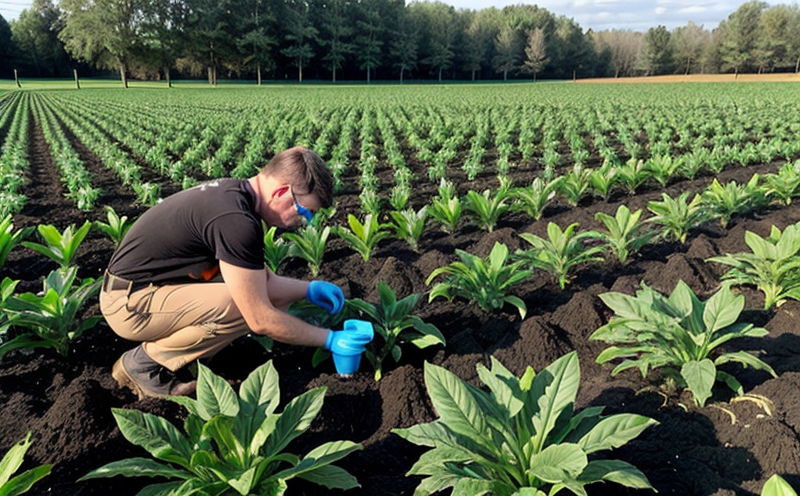Fertilizer Dust Formation Testing
Fertilizer dust formation testing is a critical aspect of ensuring product quality and safety in agriculture. The process involves assessing how easily fertilizers can form into dust particles, which has significant implications for both the environment and human health. In agricultural settings, dust formation can lead to respiratory issues among workers and may contaminate soil and water resources when dispersed into the atmosphere.
The testing of fertilizer dust formation is particularly important in the context of compliance with international standards such as ISO 14983:2017 for solid fertilizers. This standard specifies methods for determining the potential for dust explosions, which are a direct consequence of increased particle size and concentration. The aim is to prevent accidents that could lead to fires or explosions, thereby safeguarding both the environment and human lives.
The testing procedure typically involves the following steps:
- Sample preparation: Fertilizer samples must be representative of the bulk material being tested.
- Dust generation: Samples are subjected to specific mechanical processes that mimic real-world conditions, such as grinding or milling.
- Particle size analysis: The generated dust particles are analyzed for their size distribution using techniques like laser diffraction or sieving.
- Dust collection and quantification: Dust formed during the process is collected and weighed to determine its yield.
The testing process also involves evaluating other parameters such as moisture content, which can influence dust formation. This ensures that the test results are accurate and reliable. The final step in this testing procedure is reporting the findings, including any deviations from standard specifications or regulatory limits.
Understanding the nuances of fertilizer dust formation is essential for industries involved in agricultural inputs. It helps in optimizing production processes to minimize adverse effects on workers and the environment. By adhering to stringent quality control measures, manufacturers can ensure that their products meet both industry standards and customer expectations.
Applied Standards
Fertilizer dust formation testing is governed by several international standards designed to ensure product safety and compliance with regulatory requirements. These include:
- ISO 14983:2017 Solid Fertilizers — Determination of Potential for Dust Explosion: This standard provides methods for assessing the potential for dust explosions in solid fertilizers, which is crucial for preventing accidents.
- ASTM D6502-20 Standard Test Method for Determining the Explosibility of Particulate Solids: Another widely recognized method that measures the explosivity hazard of particulate solids, including fertilizers.
- EN 14917:2008 Solid Fertilizers — Particle Size Distribution: This European standard specifies the particle size distribution for solid fertilizers, which is a key factor in determining dust formation potential.
The application of these standards ensures that testing protocols are consistent and reliable across different geographical regions. Compliance with these guidelines not only enhances product safety but also promotes trust among consumers and regulatory bodies.
Benefits
Fertilizer dust formation testing offers several key benefits to various stakeholders within the agricultural sector:
- Enhanced Safety: By identifying potential risks associated with dust formation, manufacturers can implement measures to reduce hazards in production environments. This minimizes the risk of accidents and ensures a safer work environment for employees.
- Better Product Quality: Accurate testing helps maintain consistent product quality by ensuring that fertilizers meet specified particle size distributions. This leads to more effective nutrient delivery, which is crucial for optimal crop growth.
- Regulatory Compliance: Adherence to international and local standards ensures that products are compliant with regulatory requirements. This can help avoid legal penalties and maintain a positive reputation in the market.
- Improved Efficiency: Understanding dust formation characteristics allows for process optimization, reducing waste and improving overall efficiency within production facilities.
In summary, fertilizer dust formation testing plays a vital role in safeguarding both people and the environment while enhancing product quality and regulatory compliance. This testing is essential for maintaining a balance between productivity and safety in agricultural inputs.
Customer Impact and Satisfaction
Fertilizer dust formation testing not only benefits manufacturers but also has significant implications for customers, particularly farmers who rely on these products for their livelihoods. The impact of this service extends beyond the immediate production process to include long-term sustainability and profitability:
- Healthier Crops: By ensuring that fertilizers are delivered in a form that does not easily form dust, there is less risk of nutrient loss during application. This leads to more efficient use of resources and healthier crops.
- Eco-Friendly Practices: Reduced dust formation means fewer emissions into the atmosphere, contributing positively to environmental conservation efforts. This aligns with global trends toward sustainable agriculture practices.
- Cost Savings: Efficient fertilizer application reduces costs associated with reapplication due to lost nutrients. Additionally, improved efficiency in production processes translates directly into lower manufacturing expenses for customers.
- Increased Productivity: Consistent quality ensures that farmers can achieve expected yields without unexpected variations caused by poor product performance.
In conclusion, the benefits of fertilizer dust formation testing extend far beyond individual companies. They contribute to broader societal goals related to health, sustainability, and economic stability within agriculture.





